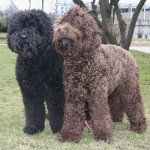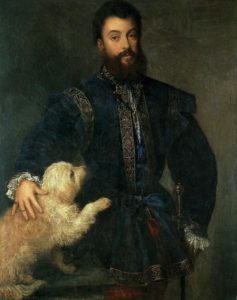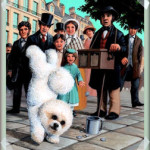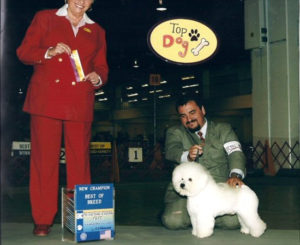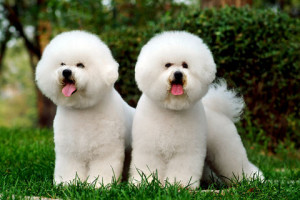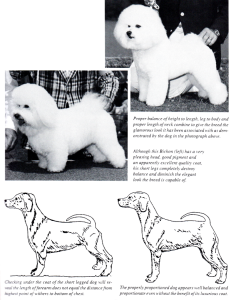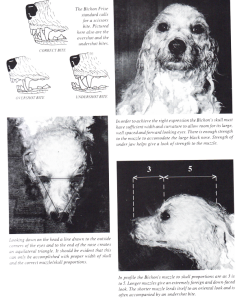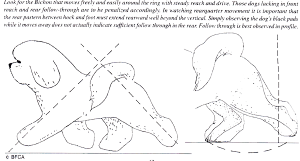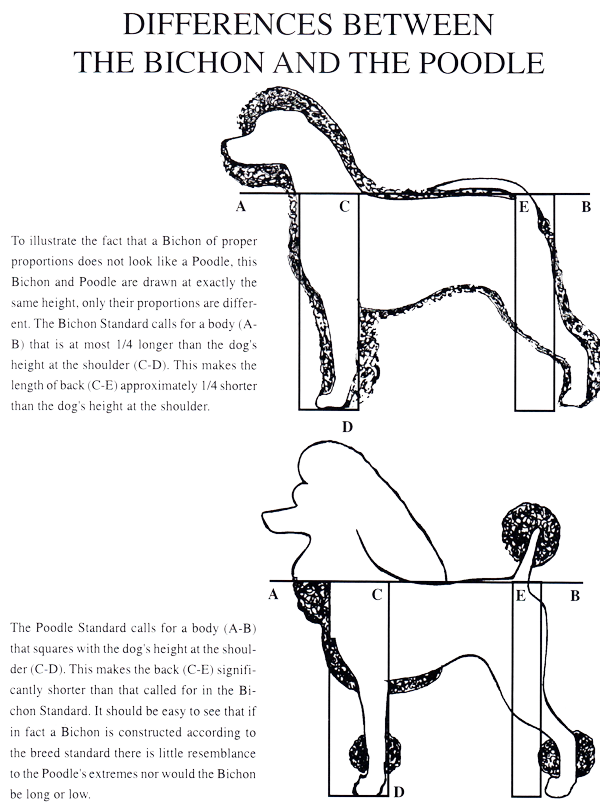The Bichon Frise is a great fun-loving companion with their own distinct personality. The Bichon Frise is a charming puffball with a loosely curled double coat consisting of a textured outer coat lined with a soft, fine, silky undercoat that is 3-4 inch long and is virtually hypoallergenic and non-shedding.
The Bichon Frise is an independent, affectionate, charming breed. They are very easy to live with and are excellent with other pets and children. The Bichon Frise is very social and is competitive and obedient.
The Bichon Frise is of Mediterranean ancestry. His oldest ancestor is the Barbet, or Water Spaniel, from which the name Barbichon came, later shortened to Bichon. Also descended from the Barbet are the Caniche, or Poodle, and the Maltese. They have certain similarities because of their common ancestry, but each long ago became a separate breed.
Valuable trade items in the Phillipines, Cuba, Argentina, and Tenerife, the largest of the Canary Islands, the Barbichon group evolved into four distinct varieties: The Bichon Bolognese (Northern Italy), the Bichon Havanese (Cuba), the Bichon Maltese (the Island of Malta) and the Bichon Tenerife . From the Bichon Tenerife came today’s Bichon Frise. These lively and affectionate dogs found their way from the Mediterranean area to the Canary Islands, specifically to the Island of Tenerife. They probably traveled as the companions of Spanish sailors, who may have used them as items of barter.
By the 1300’s, Italy had become a center of trade and commerce and, with the advent of the Renaissance, began a period of exploration. Now it was the Italian sailors who returned the Bichon to the continent. In Italy, the Bichon Tenerife attracted the attention of nobility and the new middle class of merchants. The dog was often groomed in the lion style, which was then a popular trim, but he should not be confused with the Little Lion Dog (Lowchen). Late in the 1400’s, as the French became enamoured of Italian culture, France invaded Italy, and the Italian influence spread north. Italian artists and scholars went north to serve in the French courts and, no doubt, carried along favorite pets.
It was about this time that the Tenerife or Bichon made his appearance in France, during the reign of Francis I (1515-1547), the patron of the Renaissance. His popularity grew under Henry III (1574-1589). A favorite Bichon legend says that King Henry so loved his Bichon that he carried him wherever he went in a tray-like basket attached around his neck by ribbons. What the king does, others at court imitate. The pampered, perfumed, beribboned dogs gave birth to the French verb “bichonner” (to make beautiful, to pamper). Another period of popularity in France was during the year’s of-Napoleon III (1808-1873).Many artists have included a small curly-coated lap dog or a Bichon-like figure somewhere in their portraits. Among the most famous were Titian (1490-1576) of Italy, Sir Joshua Reynolds (1723-1792), first President of the Royal Academy of England, and the Spanish artist Francisco Goya (1746-1828). These works of art help to verify the presence of the Bichon in various countries.
Two hundred years later during the French Revolution (1789-1799) the affluent and their Bichons were tossed out of their homes to find for themselves. Street entertainers adopted the agile dogs and encouraged them to perform their favorite tricks turning somersaults, walking on their hind legs and waving both paws in the air.Following World War I, a few fanciers recognized the potential of the dogs and began establishing’ their lines through controlled breeding programs. On March 5, 1933, the official standard of the breed, as written by Madam Abadie of Steren Vor Kennels, was adopted by the Societe Central Canine de France. As the breed was known by two names, Tenerife and Bichon, the President of the International Canine Federation, Mme. Nizet de Lemma’s, proposed a name based on the characteristics that the dogs presented and the name “Bichon a polio Frise” (Bichon with the curly coat) was adopted. The anglicized version is Bichon Frise (curly lap dog). On October 18, 1934, the Bichon was admitted to the official registry of the French Kennel Club.
The International Canine Federation recognizes the Bichon Frise “as a French-Belgian breed having the right to registration in the Book of Origins from all countries”. The breed is recognized in most of the world now, but then was recognized in only three countries: Belgium, France and Italy. It was the development of the Bichon Frise in the United States that was to bring about the recognition of the breed in other countries.
At the end of World War I, American soldiers brought a few of these dogs back with them as pets. Some may remember having seen them but no effort was made to breed or to keep records.
In 1956, Mr. and Mrs. Francois Picault immigrated to our country with six Bichons. They settled in Milwaukee, where their first litter arrived, sired by Eddy White de Steren Vor out of the bitch Etoile de Steren Vor. The Picaults were to eventually meet two Americans, Azalea Gascoigne, a breeder of Dachshunds, in Milwaukee, and a Collie breeder, Gertrude Fournier, in San Diego. It was some time before these ladies met. In the meantime, each had begun to Breed the Bichon Frise and each had made efforts to organize with other Bichon breeders. The Bichon Frise Club of America, formed in May 1964, was established as a result of their combined efforts. At this time Bichon enthusiasts began to increase in number. As members of BFCA, they worked diligently to establish the breed in this country and to gain recognition by the American Kennel Club. Smaller groups of Bichon breeders began to form local clubs under the guidance of the national club.
September 1, 1971, was a big day for the Bichons and their dedicated owners. It was on this date that the Bichon Frise was permitted to compete in American Kennel Club shows in the miscellaneous class. When competing in Miscellaneous, the dog receives ribbons according to his placement in the class but he is not awarded points toward his championship. Many breeds spend years in this class before being granted full recognition by AKC. However, at the October 10, 1972, meeting of the American Kennel Club, it was announced that the Bichon Frise had been granted recognition and would be eligible to compete for championship points on April 4, 1973. Hard work had paid off and a major goal was reached.Now that AKC recognition of the breed had been achieved, the next step was to have the national club recognized. Although a strong organization existed already, it had yet to become officially acknowledged. One aim of a national breed club is to hold Specialty shows, limiting entry to one breed. Under AKC guidelines, a club must hold a series of “match shows”. A match show is, in effect, a practice show. All the procedures of a point show are followed. Four match shows were held, hosted by local clubs in San Diego, Atlanta, Virginia and New York, from April 7, 1973, through October 26, 1975. With the last match, all the requirements had been met. Permission was granted on November 26, 1975, for BFCA to conduct the first Specialty. The first National Bichon Frise Club of America Specialty, obedience Trial and Sweepstakes was held on May 14, 1976, and was hosted by the Bichon Frise Club of San Diego.
The next major undertaking was a revision of the Standard, that guideline by which all Bichons are judged and toward which all breeding must be aimed. Following months of preparation, the Revised Standard was presented to the membership of BFCA for approval and, subsequently, to the American Kennel Club. Its current version was approved on October 11, 1988, and can be found in this book. The new standard is a more complete word picture of the perfect Bichon. In the future, it will be accompanied by an Illustrated Standard.
Since 1976, each local Bichon Club has been given the opportunity to bid on hosting the Specialty, held in the spring. Many local clubs now conduct their own specialties while some clubs hold AKC sanctioned B or A specialty matches. But it is the annual National Specialty, which is most eagerly anticipated. Bichon owners throughout North America attend. The highlight of the week is the show itself and each seems more beautiful than the last. There is no sight more spectacular than a room full of perfectly groomed Bichons Frises. It is with a great deal of pride that the Bichon Frise Club of America looks back on the history of this “small, sturdy, white powder puff of a dog with the merry temperament”* – The Bichon Frise.
* from the Revised Standard for the Bichon Frise
The Bichon Frise in Art is an online exhibition assembled by Edward J. Shephard Jr. This is an exhibition of depictions of the Bichon Frisé in various works of art spanning over 2,000 years. It includes artworks that explicitly identify the subjects as Bichons or as ancestors of the breed, as well as other works that I (in my admittedly non-expert judgment) have deemed to be possible depictions of the Bichon Frisé or its ancestors.
Bichon Frise Breed Standard
General Appearance
The Bichon Frise is a small, sturdy, white powder puff of a dog whose merry temperament is evidenced by his plumed tail carried jauntily over the back and his dark-eyed inquisitive expression.
This is a breed that has no gross or incapacitating exaggerations and therefore there is no inherent reason for lack of balance or unsound movement.
Any deviation from the ideal described in the standard should be penalized to the extent of the deviation. Structural faults common to all breeds are as undesirable in the Bichon Frise as in any other breed, even though such faults may not be specifically mentioned in the standard.
Size, Proportion, Substance
Size Dogs and bitches 9½ to 11½ inches are to be given primary preference. Only where the comparative superiority of a specimen outside this range clearly justifies it should greater latitude be taken. In no case, however, should this latitude ever extend over 12 inches or under 9 inches. The minimum limits do not apply to puppies. Proportion–The body from the forward-most point of the chest to the point of rump is ¼ longer than the height at the withers. The body from the withers to lowest point of chest represents ½ the distance from withers to ground. Substance–Compact and of medium bone throughout; neither coarse nor fine.Head
Neck, Topline and Body
The arched neck is long and carried proudly behind an erect head. It blends smoothly into the shoulders. The length of neck from occiput to withers is approximately 1/3 the distance from forechest to buttocks. The topline is level except for a slight, muscular arch over the loin. Body–The chest is well developed and wide enough to allow free and unrestricted movement of the front legs. The lowest point of the chest extends at least to the elbow. The rib cage is moderately sprung and extends back to a short and muscular loin. The forechest is well pronounced and protrudes slightly forward of the point of shoulder. The underline has a moderate tuck-up. Tail is well plumed, set on level with the topline and curved gracefully over the back so that the hair of the tail rests on the back. When the tail is extended toward the head it reaches at least halfway to the withers. A low tail set, a tail carried perpendicularly to the back, or a tail which droops behind is to be severely penalized. A corkscrew tail is a very serious fault.
Forequarters
Shoulders–The shoulder blade, upper arm and forearm are approximately equal in length. The shoulders are laid back to somewhat near a forty-five degree angle. The upper arm extends well back so the elbow is placed directly below the withers when viewed from the side. Legs are of medium bone; straight, with no bow or curve in the forearm or wrist. The elbows are held close to the body. The pasterns slope slightly from the vertical. The dewclaws may be removed. The feet are tight and round, resembling those of a cat and point directly forward, turning neither in nor out. Pads are black. Nails are kept short.
Hindquarters
The hindquarters are of medium bone, well angulated with muscular thighs and spaced moderately wide. The upper and lower thigh are nearly equal in length meeting at a well bent stifle joint. The leg from hock joint to foot pad is perpendicular to the ground. Dewclaws may be removed. Paws are tight and round with black pads.
Coat
The texture of the coat is of utmost importance. The undercoat is soft and dense, the outercoat of a coarser and curlier texture. The combination of the two gives a soft but substantial feel to the touch which is similar to plush or velvet and when patted springs back. When bathed and brushed, it stands off the body, creating an overall powder puff appearance. A wiry coat is not desirable. A limp, silky coat, a coat that lies down, or a lack of undercoat are very serious faults. Trimming–The coat is trimmed to reveal the natural outline of the body. It is rounded off from any direction and never cut so short as to create an overly trimmed or squared off appearance. The furnishings of the head, beard, moustache, ears and tail are left longer. The longer head hair is trimmed to create an overall rounded impression. The topline is trimmed to appear level. The coat is long enough to maintain the powder puff look which is characteristic of the breed.
Color
Color is white, may have shadings of buff, cream or apricot around the ears or on the body. Any color in excess of 10% of the entire coat of a mature specimen is a fault and should be penalized, but color of the accepted shadings should not be faulted in puppies.
Movement at a trot is free, precise and effortless. In profile the forelegs and hind legs extend equally with an easy reach and drive that maintain a steady topline. When moving, the head and neck remain somewhat erect and as speed increases there is a very slight convergence of legs toward the center line. Moving away, the hindquarters travel with moderate width between them and the foot pads can be seen. Coming and going, his movement is precise and true.
Temperament
Gentle mannered, sensitive, playful and affectionate. A cheerful attitude is the hallmark of the breed and one should settle for nothing less.
Approved October 11, 1988
Effective November 30, 1988
